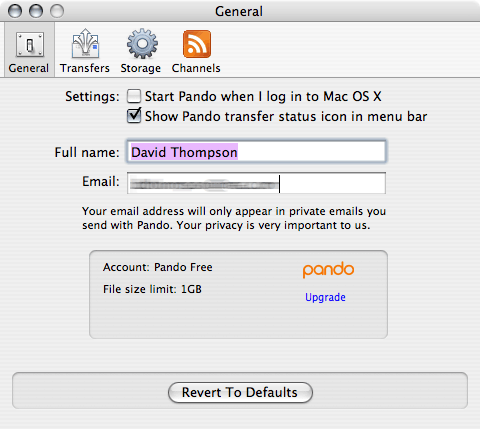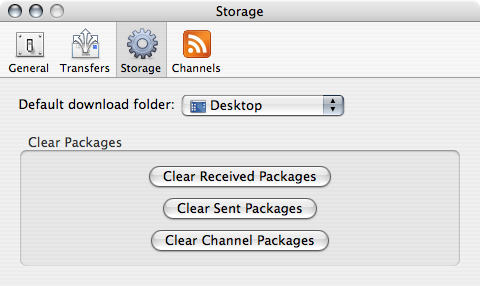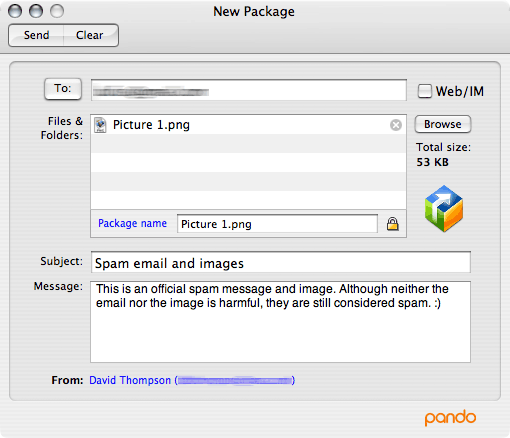Software Review
Pando 1.5.5.1

Developer: Pando Networks
Price: Free version or paid subscription (see text)
Requirements: Mac OS X 10.3.9. Universal.
Trial: Fully-featured (limited server storage, downloads, and bandwidth)
A couple of months ago, I needed to send my wife a set of images. Although each image was only a couple of megabytes in size, the lot of images amounted to more than 80 megabytes. I could have uploaded them to my Web site and sent her a link. But I have limited storage and limited bandwidth (not terribly limited, but there is a limit). I didn’t want to send 40 e-mails, each with a single image, because of the hassle on both ends. Furthermore, most e-mail servers limit attachments to a few megabytes anyway. (For example, .Mac limits attachments to five megabytes. Gmail also has a limit, but it’s larger, maybe ten megabytes. Most companies limit attachment size as well.)
So I needed a solution to my problem. When I had my Linux boxes at the university, one of them was set up to be a Web server. When I had a batch of images to send to someone, I put them in an archive, uploaded them to my server, and e-mailed a link to the recipient.
But I no longer work at the university, and I didn’t really want to use my Web site bandwidth to send images. So I needed an alternative. Enter Pando.
Installation and Use
Like almost every OS X installation I’ve done, installation is simple. I downloaded the disk image, mounted it, and copied the Pando software to the Applications folder.
There are four entries on the Preferences pane: General, Transfers, Storage, and RSS. Contact information is entered on the General tab. If you prefer, Pando can be added to the list of programs to open on login. I prefer to start the service when I need it. Your mileage may vary.
On the Storage tab, I entered the location I want Pando to store inbound files. I put mine in my regular downloads folder—that may not be the most intelligent choice because inbound files are intermixed with my browser downloads. But Pando has a facility for revealing downloaded files. Inbound files could be put somewhere else, if you preferred. If you want to preserve some upstream bandwidth, a throttle is available on the Transfers tab. I usually just let mine run. If you use a proxy, there is a setting for that, too. All in all, configuration was pretty simple.
I don’t have time to read (more) RSS feeds, so I have not explored that option.
The main program window has one pane with three options. The received listing shows the inbound files you received or those in progress. The snapshot below shows the file one of my students sent for my review. (It’s boring technical stuff so don’t ask!) The sent listing shows outbound files, although my sent-files list is currently empty.
Sending a file is simple. Click the Send New button, and a dialog appears. Enter the recipient’s e-mail address (or IM) in the To field, browse or drag files and/or folders, and name the package. Below the file list is a Subject line and a Message box. When I sent my wife the archive of images, I used “Images for you” for the subject and wrote a short (very short) message. When everything suited me, I clicked the Send button, my file began uploading, and an e-mail was sent to her.
There are limitations to the service. The free service limits uploads to a gigabyte of files at a time. Packages expire in 14 days. Server storage is limited to five gigabytes. Only ten recipients per upload are allowed. Download speeds are throttled.
The limitations can be alleviated by purchasing more service. Pando offers four levels of service at a range of prices. The prices don’t seem out of line if you need this service.
Conclusions
I sometimes need to send files larger than appropriate for an e-mail attachment. Most of us don’t have access to an FTP site, and we wouldn’t want our personal files accessible via that fashion anyway. A Web server is a possibility. But many people don’t have a Web site, and most don’t know how to set up a drop zone anyway. The need exists for some way to send large files.
The Pando software and service fills this need. Pando is kind enough to offer a free level of service. I tried it, and it just works. It’s clean and, dare I say it, it works with Windows. In my opinion, this is an excellent program and service. It fills a real niche.





Reader Comments (5)
I found http://dropload.com/
It worked easily and well. Oddly, as I write this, I checked dropload and I cannot connect to that site.
Robert, sorry to hear that you had trouble setting up Pando. If interested in trying the program again, please drop us a line at support at pandodotcom and we will see if we can help you get through your connection issues.
Same goes for anyone else, but the great majority of our users have little trouble using Pando.
Peter
Pando Support.
PS: I tried checking out the dropload service to compare it to Pando, and it was down!
Add A Comment